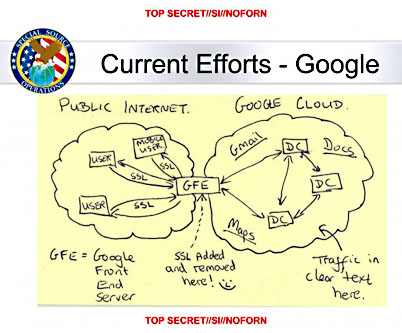As we all know, the NSA has a program called PRISM that allows it to collect vast amounts of information from companies like Google and Yahoo. Apparently, though, PRISM isn’t vast enough. The Washington Post reports today that NSA collects even vaster amounts  under a program called MUSCULAR that has hacked into the internal networks where documents are moved around before they’re encrypted:
under a program called MUSCULAR that has hacked into the internal networks where documents are moved around before they’re encrypted:
According to a top secret accounting dated Jan. 9, 2013, NSA’s acquisitions directorate sends millions of records every day from Yahoo and Google internal networks to data warehouses at the agency’s Fort Meade headquarters. In the preceding 30 days, the report said, field collectors had processed and sent back 181,280,466 new records — ranging from “metadata,” which would indicate who sent or received e-mails and when, to content such as text, audio and video.
….The MUSCULAR project appears to be an unusually aggressive use of NSA tradecraft against flagship American companies. The agency is built for high-tech spying, with a wide range of digital tools, but it has not been known to use them routinely against U.S. companies.
….For the MUSCULAR project, the GCHQ [the British counterpart of the NSA] directs all intake into a “buffer” that can hold three to five days of traffic before recycling storage space. From the buffer, custom-built NSA tools unpack and decode the special data formats that the two companies use inside their clouds. Then the data is sent through a series of filters to “select” information the NSA wants and “defeat” what it does not.
This is apparently all done overseas in order to evade rules that govern domestic data collection. According to the story, “Two engineers with close ties to Google exploded in profanity when they saw the drawing.” As always, read the whole thing.


















